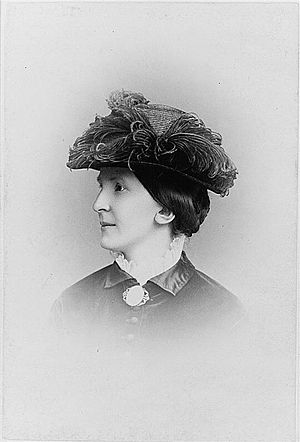Anna Hierta-Retzius facts for kids

Anna Wilhelmina Hierta-Retzius (born Hierta, August 24, 1841 – December 21, 1924) was an important Swedish woman who worked hard for women's rights and helped many people. She was a co-founder of the Married Woman's Property Rights Association in 1873, which fought for married women to have more control over their own money. Anna also started an evening school called Torsdagsskolan and was involved in many other groups that aimed to improve society. She was a leader in the Swedish National Council of Women and helped start the first female police officers in Sweden.
Contents
Early Life and Education
Anna Hierta-Retzius grew up in a very smart and active family. Her father, Lars Johan Hierta, started a well-known newspaper called Aftonbladet. Their home was often filled with artists, writers, and politicians. Anna learned a lot from her parents: her mother taught her about helping others, and her father inspired her with ideas about equality. She wanted to make a big difference in the world.
Anna went to one of the first serious public education programs for women in Sweden, called Lärokursen för fruntimmer, from 1859 to 1861. This program was created because people were talking a lot about how important it was for women to get a good education. After her studies, Anna quickly started working to improve society, guided by her belief in helping people and making things fair.
Helping with Education
After finishing her own education, Anna became a teacher. In 1864, she opened her own evening school, Torsdagsskolan, for young women from working families. Here, she taught them reading, writing, science, history, geography, and sewing. She also set up a library and a small bank for these women.
Anna believed that girls should have good physical education. She suggested adding gymnastics to school programs for girls. In 1880, she started the Stockholm Museum of Gymnastics, which she later gave to the city in 1892. She also supported schools that taught boys and girls together, believing it was better for their health and learning.
Fighting for Women's Rights
In 1873, women in Sweden were finally allowed to study at universities. Anna and her sister quickly set up a scholarship fund to help female students pay for their studies. In the same year, Anna helped start the Married Woman's Property Rights Association. This was the very first organization in Sweden focused on women's rights.
Anna was inspired by her father, who had tried to change laws about married women's property rights. After he passed away, she wanted to continue his work. The association was very successful! Soon after it started, married women gained the right to control their own earnings, even though their husbands still had some control over their other property.
Anna also worked to make sure women knew they could vote in local elections, a right they had since 1862 if they paid taxes. She encouraged them to use their vote. Later, she campaigned for women to be able to be elected to school boards and other community groups.
As a major owner of the Aftonbladet newspaper, Anna helped hire Maria Cederschiöld, who became an important pioneer for women journalists.
From 1899 to 1911, Anna was the leader of the Swedish Women's National Council. In this role, she traveled to international meetings and helped start a discussion that led to the first female police officers being hired in Sweden in 1908.
Helping the Community
When her mother passed away in 1878, Anna became responsible for her parents' money. She decided to use it to help others. She started a charity fund called Stiftelsen Lars Hiertas Minne. Through this fund, she supported many good causes, scientific discoveries, culture, and social improvements.
One of her big projects was starting the first "working cottage" in 1887. These places were inspired by similar ideas in Denmark. Poor children could come and make handicrafts in exchange for food. This idea grew, and soon there were about 90 such cottages across Sweden, and even in Russia and Poland. The main goal was to give children of working parents a safe and useful place to be during the day, instead of being left alone.
Anna also helped introduce a system to provide healthy homes for working people.
Later Life
Later in her life, Anna Hierta-Retzius became known for having more traditional views. This change might have been due to some difficult personal discoveries about her family history after her mother's death. These discoveries were very upsetting for her and may have made her views stricter over time.
In the 1900s, she became known for criticizing new, more modern books and ideas. In 1912, she even spoke out against women getting the right to vote in national elections, which was a change from her earlier support for women's rights.
Despite these later changes in her views, Anna Hierta-Retzius was recognized for her many contributions to society. She received a special award called Illis Quorum in 1907.
Images for kids


